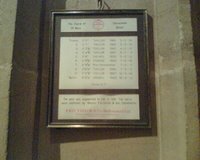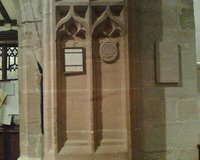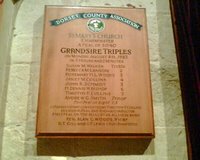Ringing in the ears?

I am a bell ringer. It's a particularly English thing - to hang heavy bells on wheels, so that they can be rung precisely, and not just clang about like all other countries' bells (unless they have had the English up 'em some time in the colonial past)
There were no ringers in our village, so I had been living in Dorset for a few years until I saw an advert for a short course. And as soon as my hand touched the fluffy bit of the rope (the sally) I was hooked!
I have seen more Dorset villages (and Dorset pubs) by visiting other towers than I would have done otherwise. Bell ringers are a sociable lot on the whole, and usually nice people. You can always visit other towers around the country and be sure of a warm welcome. There is a slightly worrying tendency in male ringers to enjoy trains, especially the steam variety. Hmmm.
There were no ringers in our village, so I had been living in Dorset for a few years until I saw an advert for a short course. And as soon as my hand touched the fluffy bit of the rope (the sally) I was hooked!
I have seen more Dorset villages (and Dorset pubs) by visiting other towers than I would have done otherwise. Bell ringers are a sociable lot on the whole, and usually nice people. You can always visit other towers around the country and be sure of a warm welcome. There is a slightly worrying tendency in male ringers to enjoy trains, especially the steam variety. Hmmm.

There still are no ringers in our village (except for me) so I ring in the nearby village, Charminster, where I learned. Last practice night (each Thursday) I was a bit bored at one point, so I took some photos with my phone of the church and the practice.

We ring on the ground floor and the tower is nearly the oldest part of the church. The ropes are very long and you have to pull very straight (though there are guides for the ropes to go through)

You dont have to be strong but the heaviest bell does weigh 14cwt (hundredweight) - thats as heavy as a small car! This is a list of the bells, all ten of them (which is an unusually large amount for a parish church, more usually only six) Most of them were originally cast around the 1600s, but have been recast since.

The building of it in the fifteenth century was paid for by a local wealthy man, Thomas Trenchard - hence the intertwined "T" symbol to be found everywhere. I like it, it reminds me of a labyrinth. Very elegant anyway.

I reckon those early stone masons were a bit on the pagan side. One of them slipped in the little carving of .. I dont know what it is. But it is in relief, so not just gouged out quickly but done with care. Its hidden and high up and faces the back of the church, so you only see it if you are in the ringing area. I enjoy feeling the link with the craftsmen all those years ago.

There is some early graffiti dated 1717 I think. Little terror, I wonder who he was - that naughty Henry Harbin.

The interwined Ts, the graffiti and the list of bells are all on the stone work on one side of the arch to our ringing area - we stand around the font to ring, as the bells are up in the top of the tower immediately above us.

This is a peal board, to commemorate a long length of ringing - a peal. That means not going wrong or stopping for about three hours. Too much for me, though I have rung the odd quarter peal - that's only ringing for about three quarters of an hour. Quite enough!
Ringing is a bit like knitting or macramé. You have a pattern or method where the bells change place at every stroke. The changes can be called slowly, which is much easier and what we normally do on Sundays. It sounds nicer as there is less chance of going wrong. Some of the methods are very old. One of the changes that is called is known as Queen's, because it is supposed to have been a favourite of Queen Elizabeth the First. Just about possible we think, given the state of bells at that time.
It is also a good investment in the future. One of our ringers is nearly eighty but you wouldnt know to look at her. It seems to keep your mind supple and your body active. With that and t'ai chi I am aiming to keep going into my crone hood!
Ringing is a bit like knitting or macramé. You have a pattern or method where the bells change place at every stroke. The changes can be called slowly, which is much easier and what we normally do on Sundays. It sounds nicer as there is less chance of going wrong. Some of the methods are very old. One of the changes that is called is known as Queen's, because it is supposed to have been a favourite of Queen Elizabeth the First. Just about possible we think, given the state of bells at that time.
It is also a good investment in the future. One of our ringers is nearly eighty but you wouldnt know to look at her. It seems to keep your mind supple and your body active. With that and t'ai chi I am aiming to keep going into my crone hood!





4 Comments:
What an absolutely fascinating post! Did not have a clue about any of that stuff. I am now curious to know if there are any bell ringers in Australia. I think it's all rather pagan here, churches being sold off to trendies who do them up into rather nice living accommodation. Got a kick out of the ancient grafitti!
Now a question: is the English style of ringing the one where the first note starts out low, then leaps an octave and descends over 7 notes (total of 8 notes before starting over again) or is it like what I've heard in Germany, more like a tolling of different notes. Don't know how else to describe it, but it's more somber sounding.
How very interesting! Thanks for telling us about this. You have some fascinating hobbies Val. Sounds like lots of fun.
The phone pics came out well. What a pretty old church that is..beautiful stone work and tower. Interesting graffiti and carving. Makes you wonder, doesn't it?
Wonderful post, Val. Whilst in England we loved visiting village churches, even better if there were bell ringers in action.
I live in a city with very few churches - many church services are held in school buildings or halls - and the newer churches here don't have bells.
Certainly, the music of the bells pealing out over European cities and villages is one I'd never tire of.
I remember climbing up onto the roof of a Church in Rye (St Mary's, I think) to have a look at the view. Descending the steps through the belfrey the bells began to peal. I was right beside a large bell when it rang, and all I wanted to do was get out of there before the next one rang!
I used to ring at Charminster, when it was a ring of 8. The tenor bell was once let down on a chain, hence the dents on the lid of the font. It was the Timothy F Collins named on the peal board, that got the 2 extra bells added to make the ring of 10. My name should be on one of the other boards, as I rang my first full peal there around 1984. If you think 14cwt is heavy, try ringing at Sherborne Abbey, which has the heaviest ring of 8 bells in the world, with a 46cwt tenor!
Post a Comment
<< Home